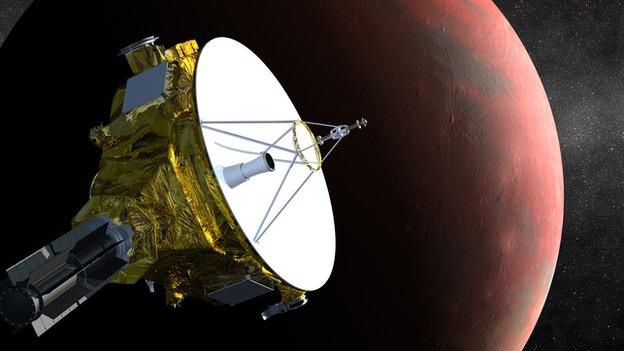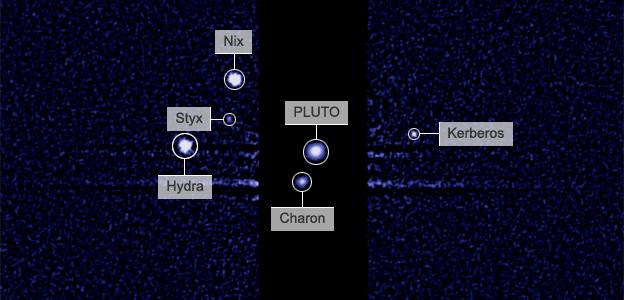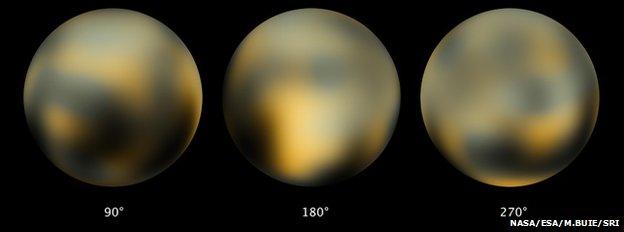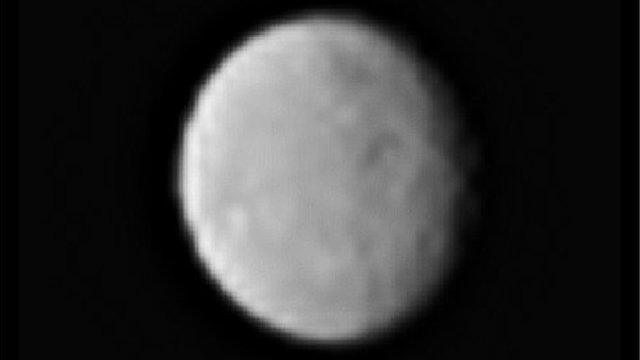New Horizons probe eyes Pluto for historic encounter
- Published

When it gets to Pluto, the New Horizons probe will have a packed schedule of observations
A Nasa probe is to start photographing the icy world of Pluto, to prepare itself for a historic encounter in July.
The New Horizons spacecraft has travelled 5bn km (3bn miles) over nine years to get near the dwarf planet.
And with 200m km still to go, its images of Pluto will show only a speck of light against the stars.
But the data will be critical in helping to align the probe properly for what will be just a fleeting fly-by.
Pluto will be photographed repeatedly during the approach, to determine the probe's position relative to the dwarf planet, explained Mark Holdridge, from the Johns Hopkins University's Applied Physics Laboratory (JHUAPL) in Baltimore.
"We then perform a number of correction manoeuvres to realign our trajectory with the reference trajectory, thus ensuring we hit our aim point to travel through the Pluto system," he said.
Any initial correction is likely to be made in March.

The Pluto system has five known moons. Others may be discovered in the coming months
When New Horizons arrives at Pluto it will be moving so fast - at almost 14km/s - that going into orbit around the distant world is impossible; it must barrel straight through instead.
One complication is that the seven different instruments aboard the spacecraft need to work at different distances to get their data, and so the team has constructed a very elaborate observation schedule for them all.
But what this means is that very precise timing will be required to make sure the flyby runs smoothly.
The closest approach to Pluto is set for around 11:50 GMT on 14 July - at a miss distance of roughly 13,695km from the surface.
Mission planners want the exact timings nailed to within 100 seconds. New Horizons will know then where and when to point the instruments.

Dwarf Planet Pluto - Demoted but undiminished

Hubble's best is a synthetic composite of multiple views. What are those shapes?
Discovered by Clyde Tombaugh on 18 February 1930
It is named after the Roman god of the underworld
An average of 5.9bn km from Sun and orbits every 248 years
Measuring its diameter is difficult but roughly 2,300km
It has a thin nitrogen atmosphere that comes and goes

The Pluto mission is being billed as the last great encounter in planetary exploration.
For people who grew up with the idea that there were "nine planets", this is the moment they get to complete the set.
Robotic probes have been to all the others, even the distant Uranus and Neptune. Pluto is the last of the "classical nine" to receive a visit.
Of course, this 2,300km-wide ice-covered rock was demoted in 2006 to the status of mere "dwarf planet", but scientists say that should not dull our enthusiasm.
The dwarfs are the most numerous planetary class in the Solar System, and Nasa's New Horizons probe is one of the first opportunities to study an example up close.
The first set of navigation pictures may not be anything special, but by May, the probe will be returning views of Pluto that are better than anything from Hubble. Come July, the view should be spectacular, said Andy Cheng, the principal investigator on the probe's main camera, which is called LORRI.
As Rebecca Morelle reports, even the Hubble Space Telescope could only capture blurry images of Pluto
"The most recent surprise we had was with the Rosetta mission. Hubble had made a 'shape model' of Comet 67P but no-one expected it to look like a rubber duckie," he told BBC News. "I am more than hopeful that we will get similar surprises with New Horizons - it's what we should expect."
Those surprises could include yet more moons (five are currently known) and possibly even rings like those seen around some of the bigger planets.
Pluto is currently 5bn km from Earth. It has taken New Horizons more than nine years to get to the dwarf's doorstep.
Once the flyby is complete, the probe will be targeted at an even more distant object in the Kuiper Belt - the name given to the icy domain beyond the main planets. Scientists think this region of space, and beyond, may contain many thousands of Pluto-like objects. Some even speculate there are far-flung worlds that rival Mars and Earth in size.
The first optical navigation images should be back on Earth by Tuesday at the latest. They will show Pluto with its largest moon, Charon.
Jonathan.Amos-INTERNET@bbc.co.uk and follow me on Twitter: @BBCAmos, external
- Published19 January 2015

- Published9 January 2015
- Published17 July 2014
- Published17 October 2012
